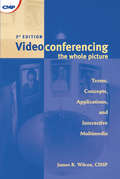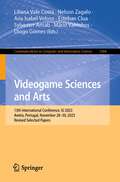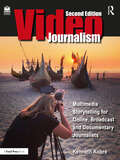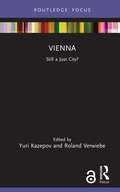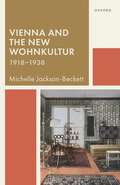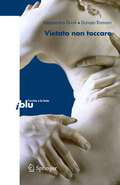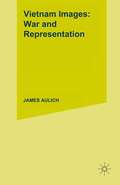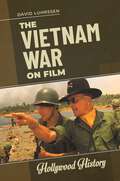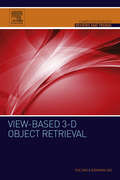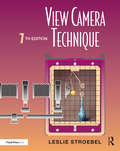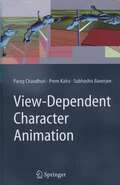- Table View
- List View
Videoconferencing: The Whole Picture
by James R. WilcoxFirst published in 2000. Routledge is an imprint of Taylor & Francis, an informa company.
Videocracy: How YouTube Is Changing the World . . . with Double Rainbows, Singing Foxes, and Other Trends We Can’t Stop Watching
by Kevin AlloccaFrom YouTube's Head of Culture and Trends, a rousing and illuminating behind-the-scenes exploration of internet video's massive impact on our world.Whether your favorite YouTube video is a cat on a Roomba, “Gangnam Style,” the “Bed Intruder” song, an ASAPscience explainer, Rebecca Black's “Friday,” or the “Evolution of Dance,” Kevin Allocca's Videocracy reveals how these beloved videos and famous trends--and many more--came to be and why they mean more than you might think. YouTube is the biggest pool of cultural data since the beginning of recorded communication, with four hundred hours of video uploaded every minute. (It would take you more than sixty-five years just to watch the vlogs, music videos, tutorials, and other content posted in a single day!) This activity reflects who we are, in all our glory and ignominy. As Allocca says, if aliens wanted to understand our planet, he'd give them Google. If they wanted to understand us, he'd give them YouTube. In Videocracy, Allocca lays bare what YouTube videos say about our society and how our actions online--watching, sharing, commenting on, and remixing the people and clips that captivate us--are changing the face of entertainment, advertising, politics, and more. Via YouTube, we are fueling social movements, enforcing human rights, and redefining art--a lot more than you'd expect from a bunch of viral clips.
Videocracy: How YouTube Is Changing the World . . . with Double Rainbows, Singing Foxes, and Other Trends We Can’t Stop Watching
by Kevin AlloccaFrom YouTube's Head of Culture and Trends, a rousing and illuminating behind-the-scenes exploration of internet video's massive impact on our world.Whether your favorite YouTube video is a cat on a Roomba, “Gangnam Style,” the “Bed Intruder” song, an ASAPscience explainer, Rebecca Black's “Friday,” or the “Evolution of Dance,” Kevin Allocca's Videocracy reveals how these beloved videos and famous trends--and many more--came to be and why they mean more than you might think. YouTube is the biggest pool of cultural data since the beginning of recorded communication, with four hundred hours of video uploaded every minute. (It would take you more than sixty-five years just to watch the vlogs, music videos, tutorials, and other content posted in a single day!) This activity reflects who we are, in all our glory and ignominy. As Allocca says, if aliens wanted to understand our planet, he'd give them Google. If they wanted to understand us, he'd give them YouTube. In Videocracy, Allocca lays bare what YouTube videos say about our society and how our actions online--watching, sharing, commenting on, and remixing the people and clips that captivate us--are changing the face of entertainment, advertising, politics, and more. Via YouTube, we are fueling social movements, enforcing human rights, and redefining art--a lot more than you'd expect from a bunch of viral clips.
Videogame Sciences and Arts: 13th International Conference, VJ 2023, Aveiro, Portugal, November 28–30, 2023, Revised Selected Papers (Communications in Computer and Information Science #1984)
by Liliana Vale Costa Nelson Zagalo Ana Isabel Veloso Esteban Clua Sylvester Arnab Mário Vairinhos Diogo GomesThis book constitutes the revised selected papers of the 13th International Conference on Videogame Sciences and Arts, VJ 2023, held in Aveiro, Portugal, during November 28–30, 2023. The 17 full papers and the 6 short papers presented were carefully reviewed and selected from 64 submissions. They are organized in topical sections named: game experience and evaluation; game-based learning and edutainment; games and culture; game design and development.
Videogame Sciences and Arts: 12th International Conference, VJ 2020, Mirandela, Portugal, November 26–28, 2020, Revised Selected Papers (Communications in Computer and Information Science #1531)
by Licínio Roque Inês Barbedo Bárbara Barroso Beatriz Legerén João Paulo SousaThis book constitutes the refereed proceedings of the 12th International Conference on Videogame Sciences and Arts, VJ 2020, held in Mirandela, Portugal, in November 2020.* The 10 full papers presented were carefully reviewed and selected from 46 submissions. *The conference was held online due to the COVID-19 pandemic.
Videogame Sciences and Arts: 11th International Conference, VJ 2019, Aveiro, Portugal, November 27–29, 2019, Proceedings (Communications in Computer and Information Science #1164)
by Nelson Zagalo Ana Isabel Veloso Liliana Costa Óscar MealhaThis book constitutes the refereed proceedings of the 11th International Conference on Videogame Sciences and Arts, VJ 2019, held in Aveiro, Portugal, in November 2019. The 20 full papers presented were carefully reviewed and selected from 50 submissions. They were organized in topical sections named: Games and Theories; Table Boards; eSports; Uses and Methodologies; Game Criticism.
Videogames And Art
by Andy Clarke Grethe MitchellVideogames are firmly enmeshed in modern culture. Acknowledging the increasing cultural impact of this rapidly changing industry on artistic and creative practices, Videogames and Art features in-depth essays that offer an unparalleled overview of the field. Together, the contributions position videogame art as an interdisciplinary mix of digital technologies and the traditional art forms. Of particular interest in this volume are machinima, game console artwork, politically oriented videogame art and the production of digital art. This new and revised edition features an extended critical introduction from the editors and updated interviews with the foremost artists in the field. Rounding out the book is a critique of the commercial videogame industry comprising essays on the current quality and originality of videogames.
Videographic Cinema: An Archaeology of Electronic Images and Imaginaries (Thinking Media)
by Jonathan RozenkrantzIn 1957, A Face in the Crowd incorporated live video images to warn about the future of broadcast TV. In 2015, Kung Fury was infused with analogue noise to evoke the nostalgic feeling of watching an old VHS tape. Between the two films, numerous ones would incorporate video images to imagine the implications of video practices. Drawing on media archaeology, Videographic Cinema shows how such images and imaginaries have emerged, changed and remained over time according to their shifting technical, historical and institutional conditions. Rediscovering forgotten films like Anti-Clock (1979) and reassessing ones like Lost Highway (1997), Jonathan Rozenkrantz charts neglected chapters of video history, including self-confrontation techniques in psychiatry, their complex relation with surveillance, and the invention/discovery of the “videographic psyche” by artists, therapists and filmmakers. Spanning six decades, Videographic Cinema discovers an epistemic shift from prospective imaginaries of surveillance and control conditioned on video as a medium for live transmission, to retrospective ones concerned with videotape as a recording memory. It ends by considering videographic filmmaking itself as a form of archaeology in the age of analogue obsolescence.
Videographic Cinema: An Archaeology of Electronic Images and Imaginaries (Thinking Media)
by Jonathan RozenkrantzIn 1957, A Face in the Crowd incorporated live video images to warn about the future of broadcast TV. In 2015, Kung Fury was infused with analogue noise to evoke the nostalgic feeling of watching an old VHS tape. Between the two films, numerous ones would incorporate video images to imagine the implications of video practices. Drawing on media archaeology, Videographic Cinema shows how such images and imaginaries have emerged, changed and remained over time according to their shifting technical, historical and institutional conditions. Rediscovering forgotten films like Anti-Clock (1979) and reassessing ones like Lost Highway (1997), Jonathan Rozenkrantz charts neglected chapters of video history, including self-confrontation techniques in psychiatry, their complex relation with surveillance, and the invention/discovery of the “videographic psyche” by artists, therapists and filmmakers. Spanning six decades, Videographic Cinema discovers an epistemic shift from prospective imaginaries of surveillance and control conditioned on video as a medium for live transmission, to retrospective ones concerned with videotape as a recording memory. It ends by considering videographic filmmaking itself as a form of archaeology in the age of analogue obsolescence.
Videojournalism: Multimedia Storytelling for Online, Broadcast and Documentary Journalists
by Kenneth KobreVideojournalism: Multimedia Storytelling for Online, Broadcast and Documentary Journalists is an essential guide for solo video storytellers—from "backpack" videojournalists to short-form documentary makers to do-it-all broadcast reporters.Based on interviews with award-winning professionals sharing their unique experiences and knowledge, Videojournalism covers topics such as crafting and editing eye-catching short stories, recording high-quality sound, and understanding the laws and ethics of filming in public and private places. Other topics include:• understanding the difference between a story and a report• finding a theme and telling a story in a compact time frame• learning to use different cameras and lenses—from smart phones to mirrorless and digital cinema cameras• using light, both natural and artificial • understanding color and exposureThe second edition of this best-selling text has been completely revised and updated. Heavily illustrated with more than 550 photographs, the book also includes more than 200 links to outstanding examples of short-form video stories. Anatomy of a News Story, a short documentary made for the book, follows a day in the life of a solo TV videojournalist on an assignment (with a surprise ending), and helps readers translate theory to practice.This book is for anyone learning how to master the art and craft of telling real, short-form stories with words, sound, and pictures for the Web or television.A supporting companion website links to documentaries and videos, and includes additional recommendations from the field’s most prominent educators.
Videojournalism: Multimedia Storytelling for Online, Broadcast and Documentary Journalists
by Kenneth KobreVideojournalism: Multimedia Storytelling for Online, Broadcast and Documentary Journalists is an essential guide for solo video storytellers—from "backpack" videojournalists to short-form documentary makers to do-it-all broadcast reporters.Based on interviews with award-winning professionals sharing their unique experiences and knowledge, Videojournalism covers topics such as crafting and editing eye-catching short stories, recording high-quality sound, and understanding the laws and ethics of filming in public and private places. Other topics include:• understanding the difference between a story and a report• finding a theme and telling a story in a compact time frame• learning to use different cameras and lenses—from smart phones to mirrorless and digital cinema cameras• using light, both natural and artificial • understanding color and exposureThe second edition of this best-selling text has been completely revised and updated. Heavily illustrated with more than 550 photographs, the book also includes more than 200 links to outstanding examples of short-form video stories. Anatomy of a News Story, a short documentary made for the book, follows a day in the life of a solo TV videojournalist on an assignment (with a surprise ending), and helps readers translate theory to practice.This book is for anyone learning how to master the art and craft of telling real, short-form stories with words, sound, and pictures for the Web or television.A supporting companion website links to documentaries and videos, and includes additional recommendations from the field’s most prominent educators.
Vienna: Still a Just City? (Built Environment City Studies)
by Yuri KazepovThis book explores and debates the urban transformations that have taken place in Vienna over the past 30 years and their consequences in policy fields such as labour and housing, political and social participation and the environment. Historically, European cities have been characterised by a strong association between social cohesion, quality of life, economic ambition and a robust State. Vienna is an excellent example for that. In more recent years, however, cities were pressured to change policy principles and mechanisms in the context of demographic shifts, post-industrial transformations and welfare recalibration which have led to worsened social conditions in many cities. Each chapter in this volume discusses Vienna’s responses to these pressures in key policy arenas, looking at outcomes from the context-specific local arrangements. Against a theoretical framework debating the European city as a model of inclusion and social justice, authors explore the local capacity to innovate urban policies and to address new social risks, while paying attention to potential trade-offs. The book questions and assesses the city’s resilience using time series and an institutional analysis of four key dimensions that characterise the European city model within the context of post-industrial transition: redistribution, recognition, representation and sustainability. It offers a multiscalar perspective of urban governance through labour, housing, participatory and environmental policies, bringing together different levels and public policy types. Vienna: Still a Just City? is aimed at academics, researchers and policy-makers in urban studies, including urban sociology, ecology, geography and welfare.
Vienna: Still a Just City? (Built Environment City Studies)
by Yuri Kazepov Roland VerwiebeThis book explores and debates the urban transformations that have taken place in Vienna over the past 30 years and their consequences in policy fields such as labour and housing, political and social participation and the environment. Historically, European cities have been characterised by a strong association between social cohesion, quality of life, economic ambition and a robust State. Vienna is an excellent example for that. In more recent years, however, cities were pressured to change policy principles and mechanisms in the context of demographic shifts, post-industrial transformations and welfare recalibration which have led to worsened social conditions in many cities. Each chapter in this volume discusses Vienna’s responses to these pressures in key policy arenas, looking at outcomes from the context-specific local arrangements. Against a theoretical framework debating the European city as a model of inclusion and social justice, authors explore the local capacity to innovate urban policies and to address new social risks, while paying attention to potential trade-offs. The book questions and assesses the city’s resilience using time series and an institutional analysis of four key dimensions that characterise the European city model within the context of post-industrial transition: redistribution, recognition, representation and sustainability. It offers a multiscalar perspective of urban governance through labour, housing, participatory and environmental policies, bringing together different levels and public policy types. Vienna: Still a Just City? is aimed at academics, researchers and policy-makers in urban studies, including urban sociology, ecology, geography and welfare.
Vienna – A Doctor’s Guide: 15 walking tours through Vienna’s medical history
by Wolfgang Regal Michael NanutThis guide is for all visitors to Vienna who are interested in the history of medicine. 15 walks through the city reveal the old medical Vienna: the Fools’ Tower, Freud’s private practice and apartment, the workplaces of many famous physicians, through the old General Hospital, the old university, and the most important pathological museums. Little-known details and anecdotes are included as well as a short history of Vienna and some gourmet tips.
Vienna and the New Wohnkultur, 1918-1938
by Michelle Jackson-BeckettWhile the domestic sphere might seem tangential to the dire political situation and humanitarian crises of interwar Europe, it was nevertheless at the forefront of debates about cultural identity and economic policy in the Viennese press, culture, and arts. Vienna and the New Wohnkultur, 1918-1938 explores why and how the Viennese design landscape was set apart--aesthetically and theoretically--from other European explorations of modern design. Jackson-Beckett examines interior design exhibitions, press, and debates about modern living in interwar Vienna, an overlooked area of modern European architecture and design history, arguing for a reconsideration of the contours of European modernism. The text analyses varied interpretations of modern domestic culture (Wohnkultur) in Vienna, and explores why these interpretations were distinct from other strands of European modernism. Vienna and the New Wohnkultur introduces new research and translation of primary sources on flexible, adaptable, and affordable design by architects, designers, and retailers. Vienna's design discourse also prefigured important postmodern and contemporary discussions on historicism, eclecticism, empathy, and user experience. Through extensive new research in archival and period sources, Jackson-Beckett illustrates how design ideas, taste, and portrayals of domestic culture of fin-de-si?cle Viennese Modernism (Wiener Moderne) were also deployed as forms of cultural and national identity both during the early years of the Social Democratic government in Vienna (1918-1934) and later under the fascist state (1934-1938).
Vienna and the New Wohnkultur, 1918-1938
by Michelle Jackson-BeckettWhile the domestic sphere might seem tangential to the dire political situation and humanitarian crises of interwar Europe, it was nevertheless at the forefront of debates about cultural identity and economic policy in the Viennese press, culture, and arts. Vienna and the New Wohnkultur, 1918-1938 explores why and how the Viennese design landscape was set apart--aesthetically and theoretically--from other European explorations of modern design. Jackson-Beckett examines interior design exhibitions, press, and debates about modern living in interwar Vienna, an overlooked area of modern European architecture and design history, arguing for a reconsideration of the contours of European modernism. The text analyses varied interpretations of modern domestic culture (Wohnkultur) in Vienna, and explores why these interpretations were distinct from other strands of European modernism. Vienna and the New Wohnkultur introduces new research and translation of primary sources on flexible, adaptable, and affordable design by architects, designers, and retailers. Vienna's design discourse also prefigured important postmodern and contemporary discussions on historicism, eclecticism, empathy, and user experience. Through extensive new research in archival and period sources, Jackson-Beckett illustrates how design ideas, taste, and portrayals of domestic culture of fin-de-si?cle Viennese Modernism (Wiener Moderne) were also deployed as forms of cultural and national identity both during the early years of the Social Democratic government in Vienna (1918-1934) and later under the fascist state (1934-1938).
The Viennese Café and Fin-de-Siècle Culture (Austrian and Habsburg Studies #16)
by Charlotte Ashby Tag Gronberg Simon Shaw-MillerThe Viennese café was a key site of urban modernity around 1900. In the rapidly growing city it functioned simultaneously as home and workplace, affording opportunities for both leisure and intellectual exchange. This volume explores the nature and function of the coffeehouse in the social, cultural, and political world of fin-de-siècle Vienna. Just as the café served as a creative meeting place within the city, so this volume initiates conversations between different disciplines focusing on Vienna at the beginning of the twentieth century. Contributions are drawn from the fields of social and cultural history, literary studies, Jewish studies and art, and architectural and design history. A fresh perspective is also provided by a selection of comparative articles exploring coffeehouse culture elsewhere in Eastern Europe.
Vietato non toccare (I blu)
by Alessandra Drioli Donato RamaniGrazie a uno stile di scrittura agile e veloce, a una ricca serie di esempi - con la descrizione di opere d'arte e performance sempre sorprendenti, bizzarre, vigorose – e a un ricco apparato iconografico questo libro vuole essere un primo e inedito tentativo di creare un ideale filo di congiunzione, ove possibile, tra esperienze diverse dell'arte nei science centre. Convinti che partendo dalla storia dei science centre da un lato e delle ricerca artistica contemporanea dall'altro per arrivare all'esperienze di ieri e di oggi, dentro e fuori l'Europa, individuando caratteristiche, peculiarità, differenze, questo libro potrà diventare un testo base, un primo esercizio per descrivere una realtà in continua espansione, dominato da una straordinaria e vitalissima entropia.
The Vietnam War on Film (Hollywood History)
by David LuhrssenVietnam War on Film illustrates how to employ film as a teaching tool. It also stands on its own as an account of the war and the major films that have depicted it.Even for many people who experienced the Vietnam War first hand, memories of that conflict have often been shaped by the popular films that depicted it: The Quiet American, The Green Berets, The Deer Hunter, Coming Home, Platoon, Full Metal Jacket, and Apocalypse Now, among others. Vietnam War on Film examines how the war is portrayed through a selection of ten iconic films that represent the war through dramatization and storytelling as opposed to through documentary footage. The book includes an introduction to the war's history and a timeline of events, followed by ten chapters, each of which focuses on a specific Vietnam War movie. Chapters offer a uniquely detailed level of historical context for the films, weighing their depiction of events against the historical record and evaluating how well or how poorly those films reflected the truth and shaped public memory and discourse over the war. A final section of "Resources" provides a comprehensive annotated bibliography of print and electronic sources to aid students and teachers in further research.
The Vietnam War on Film (Hollywood History)
by David LuhrssenVietnam War on Film illustrates how to employ film as a teaching tool. It also stands on its own as an account of the war and the major films that have depicted it.Even for many people who experienced the Vietnam War first hand, memories of that conflict have often been shaped by the popular films that depicted it: The Quiet American, The Green Berets, The Deer Hunter, Coming Home, Platoon, Full Metal Jacket, and Apocalypse Now, among others. Vietnam War on Film examines how the war is portrayed through a selection of ten iconic films that represent the war through dramatization and storytelling as opposed to through documentary footage. The book includes an introduction to the war's history and a timeline of events, followed by ten chapters, each of which focuses on a specific Vietnam War movie. Chapters offer a uniquely detailed level of historical context for the films, weighing their depiction of events against the historical record and evaluating how well or how poorly those films reflected the truth and shaped public memory and discourse over the war. A final section of "Resources" provides a comprehensive annotated bibliography of print and electronic sources to aid students and teachers in further research.
View-based 3-D Object Retrieval (Computer Science Reviews and Trends)
by Yue Gao Qionghai DaiContent-based 3-D object retrieval has attracted extensive attention recently and has applications in a variety of fields, such as, computer-aided design, tele-medicine,mobile multimedia, virtual reality, and entertainment. The development of efficient and effective content-based 3-D object retrieval techniques has enabled the use of fast 3-D reconstruction and model design. Recent technical progress, such as the development of camera technologies, has made it possible to capture the views of 3-D objects. As a result, view-based 3-D object retrieval has become an essential but challenging research topic. View-based 3-D Object Retrieval introduces and discusses the fundamental challenges in view-based 3-D object retrieval, proposes a collection of selected state-of-the-art methods for accomplishing this task developed by the authors, and summarizes recent achievements in view-based 3-D object retrieval. Part I presents an Introduction to View-based 3-D Object Retrieval, Part II discusses View Extraction, Selection, and Representation, Part III provides a deep dive into View-Based 3-D Object Comparison, and Part IV looks at future research and developments including Big Data application and geographical location-based applications.Systematically introduces view-based 3-D object retrieval, including problem definitions and settings, methodologies, and benchmark testing bedsDiscusses several key challenges in view-based 3-D object retrieval, and introduces the state-of-the-art solutionsPresents the progression from general image retrieval techniques to view-based 3-D object retrievalIntroduces future research efforts in the areas of Big Data, feature extraction, and geographical location-based applications
View Camera Technique
by Leslie StroebelNow in its seventh edition, View Camera Technique is a unique, comprehensive book that presents clearly and precisely the features, operations and applications of view cameras. It details camera movements, image formation, exposure control, and information concerning lenses and accessories. Diagrams, comparison charts, and more than 500 photographs and illustrations by distinguished professional photographers provide the reader with the tools necessary to analyze a picture situation, set up and manipulate the camera, and portray the subject to meet the expectations of the professional photographer. This text has been completely revised and updated to include over 100 brand-name view cameras, and offers comparison tables to assist readers in choosing cameras, lenses, and view-camera digital backs. This latest edition offers expanded coverage of the newest technology, including electronic features that simplify the use of view cameras for conventional photography and digital view cameras that eliminate the need for film and make it possible to modify the digital images with image-processing computer software programs
View Camera Technique
by Leslie StroebelNow in its seventh edition, View Camera Technique is a unique, comprehensive book that presents clearly and precisely the features, operations and applications of view cameras. It details camera movements, image formation, exposure control, and information concerning lenses and accessories. Diagrams, comparison charts, and more than 500 photographs and illustrations by distinguished professional photographers provide the reader with the tools necessary to analyze a picture situation, set up and manipulate the camera, and portray the subject to meet the expectations of the professional photographer. This text has been completely revised and updated to include over 100 brand-name view cameras, and offers comparison tables to assist readers in choosing cameras, lenses, and view-camera digital backs. This latest edition offers expanded coverage of the newest technology, including electronic features that simplify the use of view cameras for conventional photography and digital view cameras that eliminate the need for film and make it possible to modify the digital images with image-processing computer software programs
View-Dependent Character Animation
by Parag Chaudhuri Prem Kalra Subhashis BanerjeeCreating moving camera character animations in 3D is a multi-faceted computer graphics and computer vision problem that requires a formal representation of the moving camera, and efficient algorithms to help author manage and render the multitude of character poses required for the animation. This well-researched book introduces view-dependent character animation, covering all the relevant background work. Numerous example animations are offered to explain and illustrate this versatile technique.
